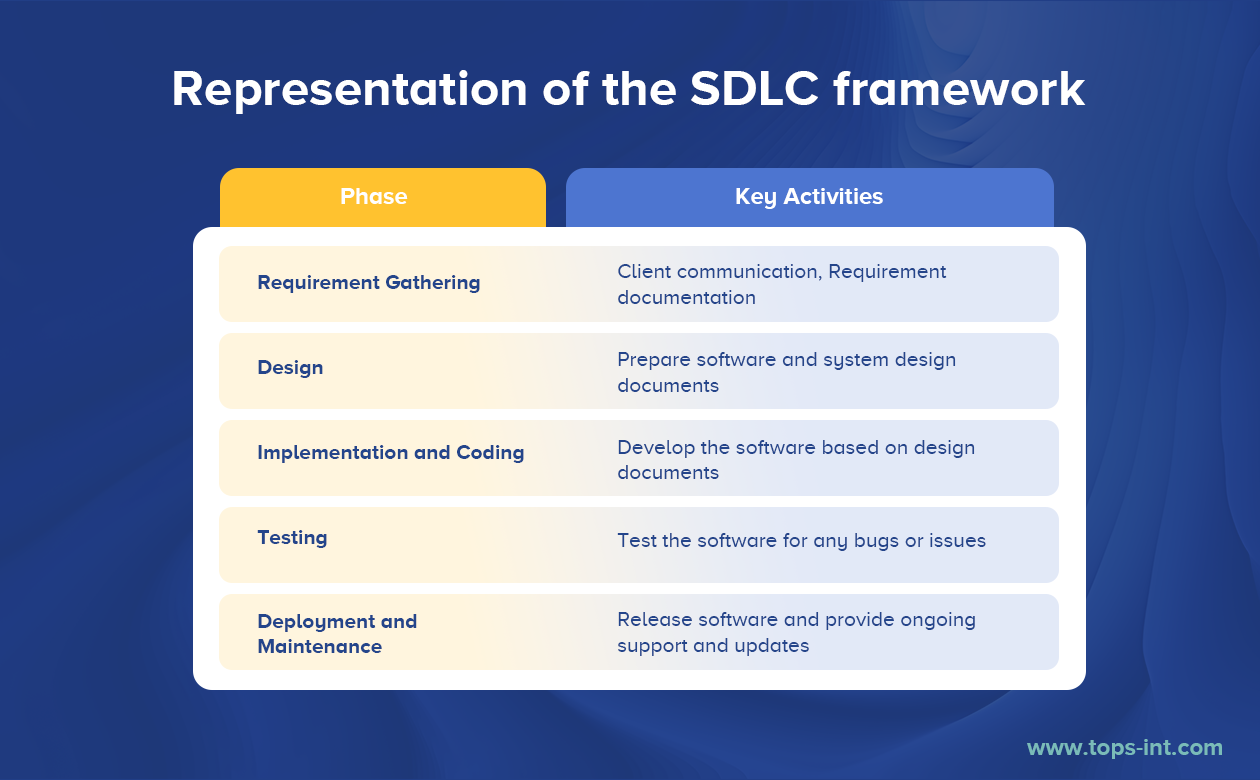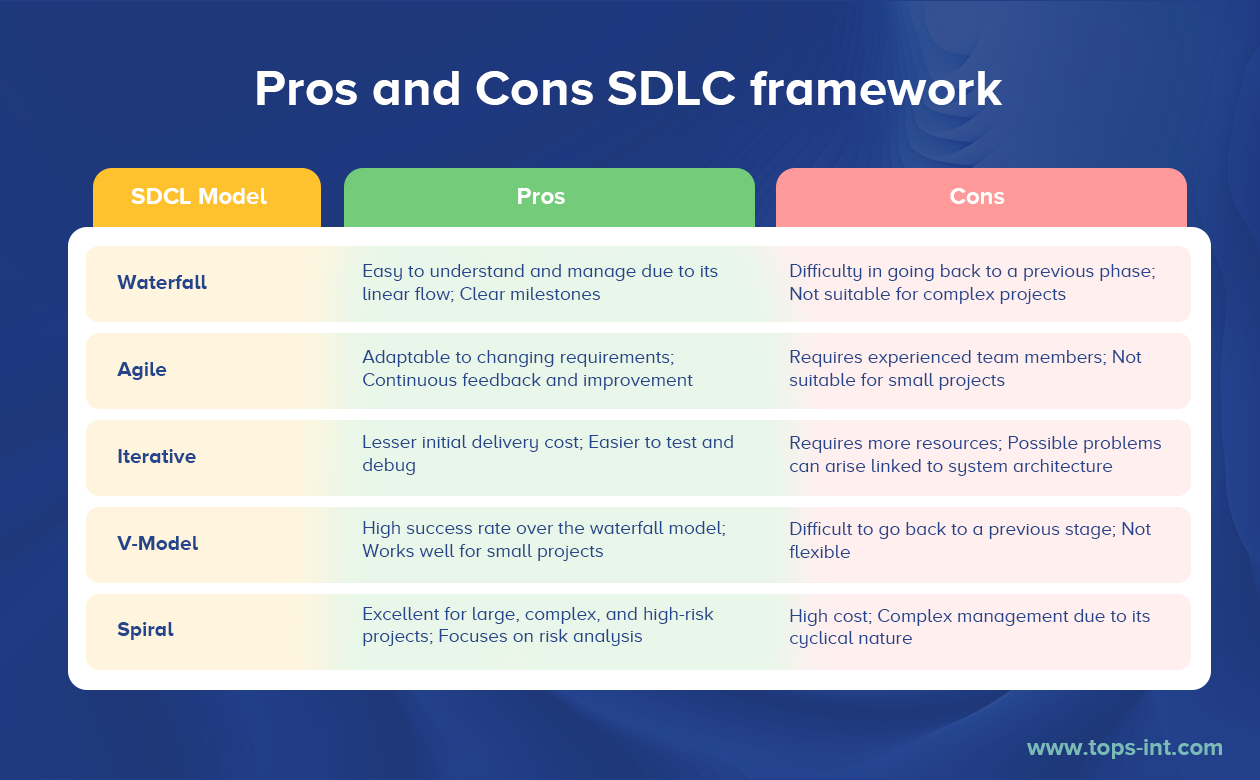The SDLC is a systematic process for building software applications. It breaks down the complex software development task into manageable segments, ensuring high quality and cost-effectiveness. If you do a Software Engineering Course you will be taught in depth about SLDC and how to implement each step properly!
The main SDLC stages include:
- Requirement Analysis: Identifying what the client needs and defining system requirements.
- Design: Detailed software and system design based on requirements.
- Implementation/Coding: Actual creation of the software.
- Testing: Ensuring the software works as intended and is bug-free.
- Deployment: Releasing the product to the market.
- Maintenance: Post-deployment software upgrades and fixes.
This was a summarised SDLC overview! Each phase has unique tasks and deliverables that feed into the next phase. You can learn more about each stage from the official site of IBM, a global leader in the tech industry.
Importance Of SDLC
The Software Development Life Cycle (SDLC) holds a vital position in the technology world. Here are the main SDLC benefits:
- Quality Control: SDLC mandates rigorous testing at every phase, which helps in the early detection and rectification of errors and defects. This emphasis on testing results in a high-quality end product. Read more about quality control in SDLC on the official ISTQB site.
- Predictability: With a clearly defined SDLC, businesses can easily anticipate timelines, resources, and costs, making project management more predictable and efficient.
- Transparency: The systematic nature of SDLC provides transparency to all stakeholders involved. This ensures everyone has a clear understanding of the project's progress.
- Risk Management: It helps in identifying risks early, thus providing ample time for risk mitigation and contingency planning.
- Maintenance & Documentation: Post-deployment maintenance is simpler with SDLC. The extensive documentation helps future development teams understand the software better.
Thus, the SDLC ensures the delivery of high-quality software and aids in project management, making it an indispensable part of any software development process.
What is Agile SDLC?
The Agile SDLC is a methodology that prioritizes flexibility and customer satisfaction. It's a non-linear approach, unlike traditional SDLC models like Waterfall, and it emphasizes collaboration, customer feedback, and small, rapid releases.
Here are the key principles of Agile SDLC:

Understanding Agile SDLC can greatly enhance a Full Stack Developer's ability, even if you have completed Full Stack Development Course! It will help you adapt and respond effectively to changes, making it a key component of modern web and software development.
Explanation Of SDLC Life Cycle! What are the SDLC Steps?
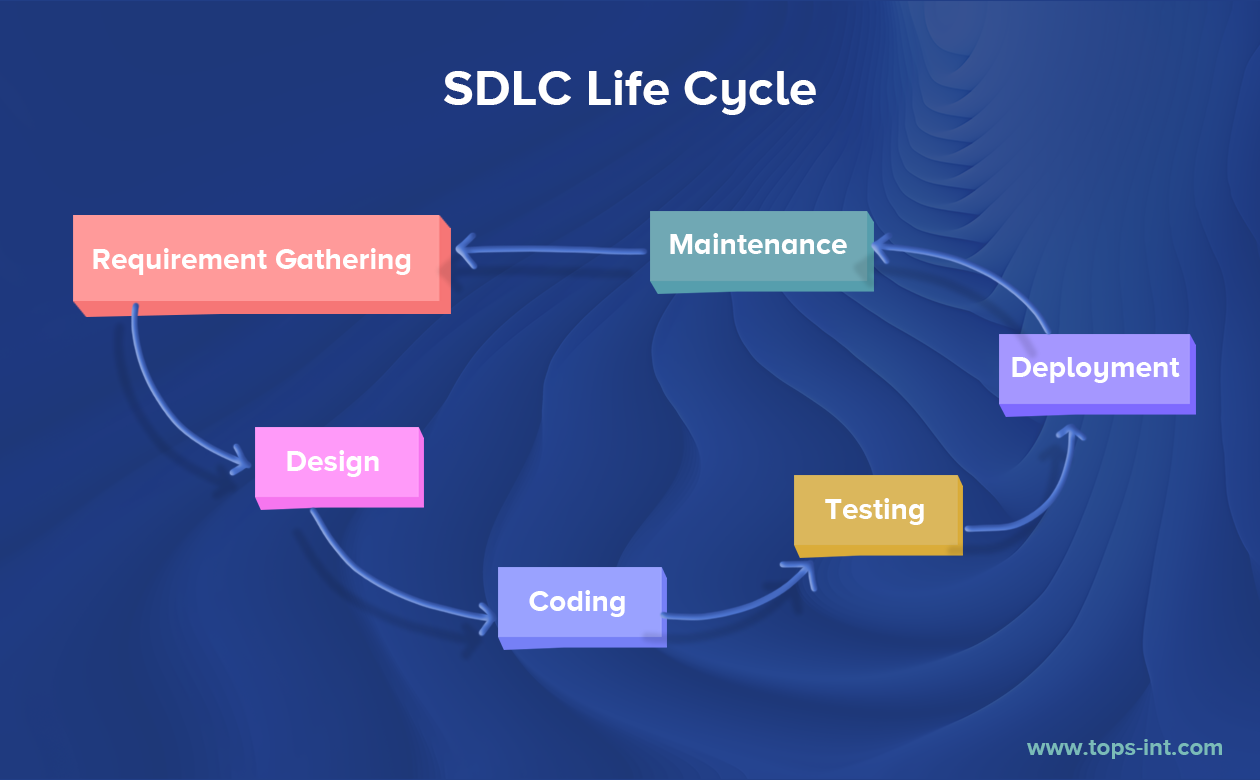
Let's delve into the different stages of the SDLC process:
SDLC explained
- Requirement Gathering and Analysis: This stage involves understanding the client's needs and defining the system's requirements. It's typically completed by skilled business analysts who communicate with stakeholders to clearly understand the software objectives.
- Design: In this stage, system, and software design documents are prepared as per the requirement specification. These documents represent the design of the software, outlining necessary details about the architecture, data flow, interfaces, and more.
- Implementation and Coding: The actual coding of the software happens here. Based on the design documents, the work is divided into units, and different units are coded by the respective developers.
- Testing: After the software is developed, it undergoes rigorous testing to ensure it's functioning as per the requirement without any bugs or issues. Testing methodologies might include unit testing, integration testing, system testing, and more.
- Deployment and Maintenance: Once the software passes the testing phase, it's deployed in the production environment or first released in a limited segment to gauge its functionality in the real world. After deployment, the software needs regular maintenance to cater to additional requirements and to deal with hidden bugs.
Here's a simple tabular representation of the SDLC framework:
To get a better understanding of each of these stages, you may want to check out this detailed guide from the
Microsoft official site. Each of these stages has its unique tasks and deliverables, which feed into the next phase.
The aim is to ensure a smooth transition from one phase to another, thereby creating high-quality software.
What are SDLC models?
The Software Development Life Cycle (SDLC) can be implemented through different models, each having its strengths and weaknesses. Here are the most popular ones:
- Waterfall SDLC Model: This model follows a linear sequential flow, where each phase depends on the deliverables of the previous one.
- Agile Model: Agile encourages testing and development iterations that are continuous across the whole software development lifecycle.
- Iterative Model: This model emphasises repetition. A simple software version is developed first and iteratively enhanced in subsequent versions.
- V-Model: It is an extension of the waterfall model, where testing activities are planned parallel to corresponding development activities.
- Spiral Model: This model focuses on risk analysis, combining the waterfall and prototype models.
Let's dive into their pros and cons:
For more detailed insights on these models, you can visit the official site of SEBoK, the Guide to the Systems Engineering Body of Knowledge. By understanding the strengths and weaknesses of each model, you can select the best fit for your specific project requirements.
Whether you're a seasoned programmer or a beginner looking to delve into the exciting realm of coding, enrolling in a comprehensive Web Development Course can provide you with the essential skills and knowledge to thrive in this ever-evolving industry.
How does SDLC address security?
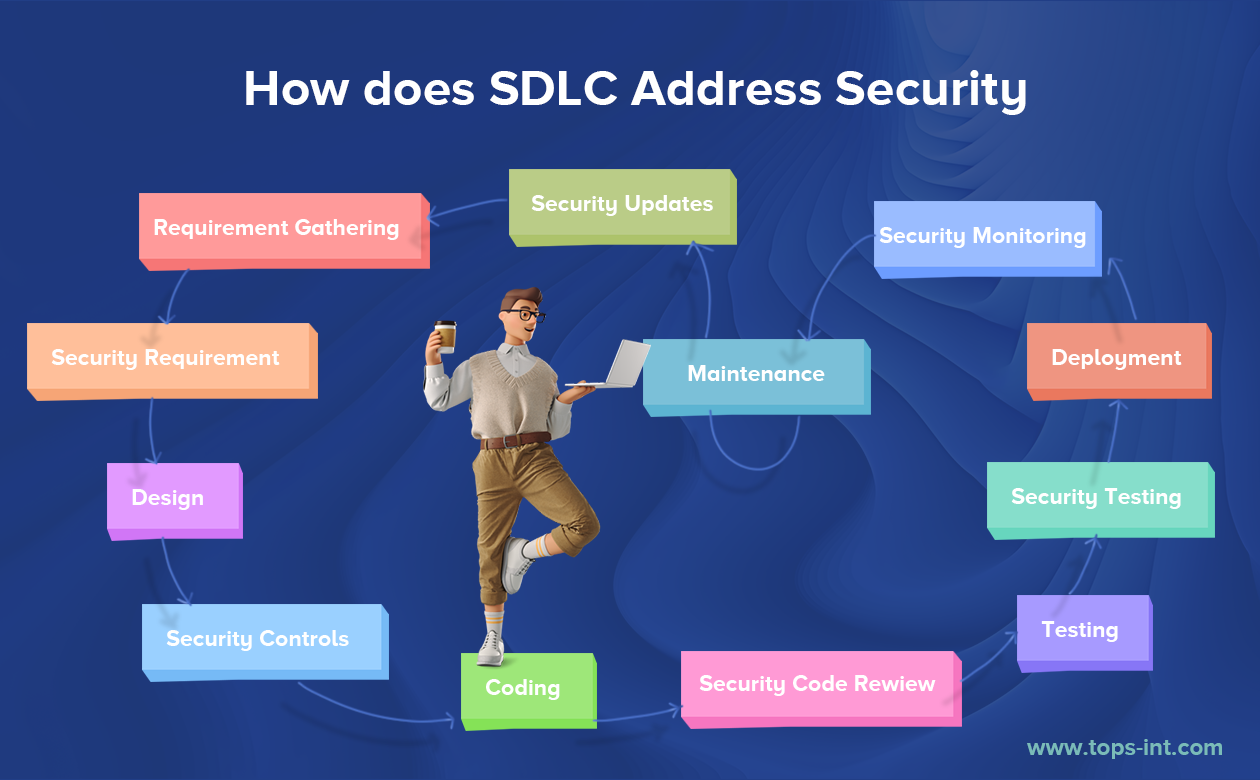
SDLC is crucial in ensuring security is ingrained throughout the development process of software.
Here's how security is addressed at each stage:
Requirement Gathering and Analysis
- Identify security requirements based on the nature of the system.
- Assess potential security risks.
Design
- Incorporate security controls in the system design.
- Perform threat modelling to identify security vulnerabilities.
Implementation and Coding
- Follow secure coding practices to minimise vulnerabilities.
- Perform static code analysis for security.
Testing
- Conduct security testing to identify and fix vulnerabilities.
- Perform penetration testing to simulate real-world attacks.
Deployment and Maintenance
- Monitor the system to detect and respond to security incidents.
- Regularly update the system to address new security threats.
Here's a tabular representation for a quick glance:

By ensuring that security is an integral part of each stage of the SDLC, it helps in the development of robust and secure software. For a deeper understanding of SDLC implementation, you might want to check the
official guide from OWASP on Secure Software Development Lifecycle.
How does the SDLC stack up against other lifecycle management techniques?
Here is an in-depth SDLC methodologies comparison:
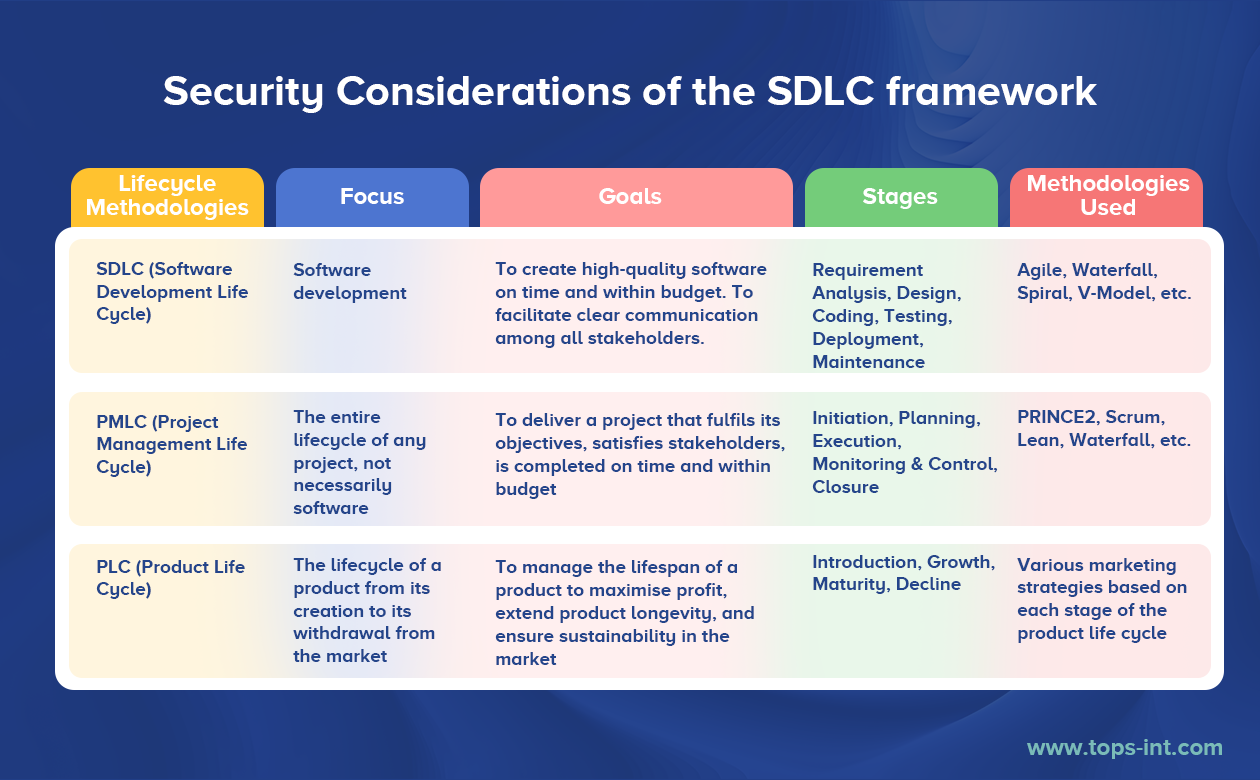
An In-depth Look at SDLC Documentation
A crucial step in the software development process is comprehending and producing SDLC (Software Development Life Cycle) documentation.
Key Types of SDLC Documentation:
- Project Plan: This document outlines the project objectives, scope, schedule, risks, and resources.
- Requirements Document: This document details what the software should do, including functional and non-functional requirements.
- Design Document: This elaborates on the system's architecture, data models, user interfaces, and algorithms.
- Test Plan: This document outlines the testing strategies, schedules, and resources, along with the criteria for pass/fail.
- User Manual: This guide provides end-users with information on how to use the software.
- Maintenance Guide: This document provides information on maintaining and troubleshooting the software.
Advantages of Proper SDLC Documentation:
- Provides clear guidelines and standards
- Ensures consistency across the project
- Facilitates communication and understanding among team members
- Aids in future maintenance and enhancements
Creating Effective SDLC Documentation
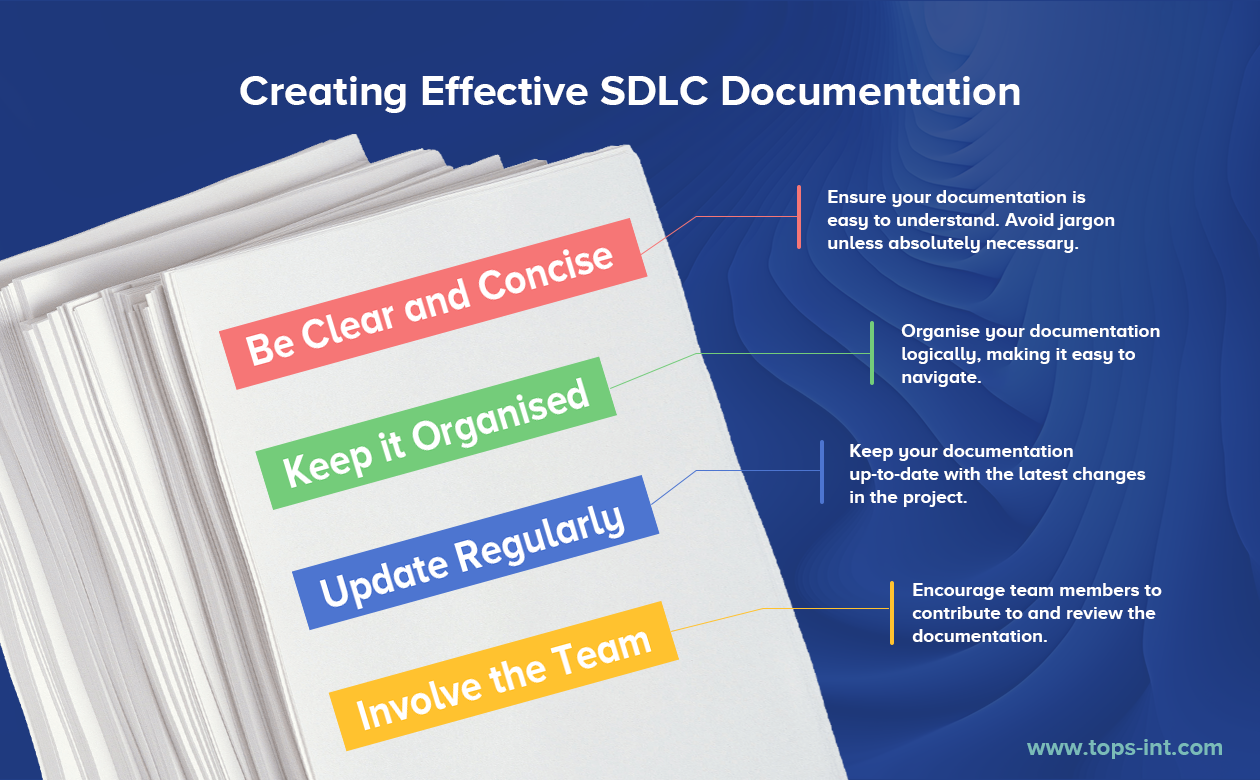
Overall, mastering SDLC documentation is a vital skill for any IT professional. By enrolling in a comprehensive course like the one offered by TOPS Technologies, you can acquire an in-depth understanding and hands-on experience in creating effective SDLC documentation.
SDLC Best Practices: A Roadmap to Success
- Understand the Business Goals: Before embarking on a software development project, thoroughly understand the business goals. This will ensure the project aligns with the organisation's objectives and needs.
- Gather Detailed Requirements: Ensure that you gather detailed and clear requirements from all stakeholders. This will minimise the chances of misunderstanding or miscommunication, leading to a product that meets expectations.
- Select the Right SDLC Model: Choose the SDLC model that best suits the project's requirements, team's capabilities, and the organisational culture. Each model has its strengths and weaknesses, so choose wisely.
- Involve Stakeholders: Involve stakeholders, including clients and end-users, at every stage of the SDLC. Their feedback can be valuable in shaping the final product.
- Plan for Testing Early: Don't leave testing to the last phase of SDLC. Plan for it from the beginning and perform testing at every stage to catch bugs and issues early.
- Embrace Changes: Change is an integral part of software development. Be prepared to accept changes and adapt your plan accordingly.
- Focus on Documentation: Document every stage of the SDLC process. This will not only facilitate communication and understanding among team members but also aid in future maintenance and enhancements.
Following these best practices can make your SDLC process more efficient, resulting in better quality software that meets or even exceeds the expected requirements.
Conclusion
Understanding the Software Development Life Cycle (SDLC) is a crucial part of becoming a skilled IT professional. But to learn it effectively, it isn't enough to merely skim through online resources. You need a systematic, comprehensive approach - something a well-structured course can provide.
This is where TOPS Technologies comes into play. As a reputed name in the IT Training & Placement Industry for over 15 years, we offer a meticulously designed SDLC course tailored to give you a deep understanding of each phase - from planning to maintenance.
At TOPS Technologies, we provide an interactive learning environment where you can engage with experienced instructors and gain practical insights into SDLC. Our course is structured to equip you with the skills to manage each step of the life cycle, giving you an edge in your IT career. Trust TOPS Technologies to guide you through your SDLC journey.
For further inquiries regarding the TOPS Technologies Course, reach out to us at inquiry@tops-int.com or call us at +91 – 7622011173 for a free demo.
FAQs
Why should I choose TOPS Technologies for software development courses?
TOPS Technologies stands out for its hands-on, industry-aligned training. Our Software Development Courses not only teach you the theoretical aspects of topics like SDLC but also provide practical experience through projects and assignments. With a focus on employability, we also offer placement assistance, leveraging our tie-ups with over 3000 companies. By choosing TOPS Technologies, you're not just learning; you're preparing for a successful career in software development.
Can learning about SDLC enhance my software development skills?
Absolutely! Any software developer must comprehend the Software Development Life Cycle (SDLC). It offers a methodical way to create superior software. You may obtain a thorough grasp of the complete software development process by learning about the many stages of the SDLC, from planning and analysis through design, development, testing, and maintenance. Software development courses at TOPS Technologies, for instance, cover SDLC in depth, ensuring you are well-equipped to handle real-world software projects.
Why is the Software Development Life Cycle important?
The SDLC is essential because it offers a disciplined framework for creating software, guaranteeing that it is effective, high-quality, and satisfies the objectives. It aids in risk management, as well as cost and time management for project completion.
How does the SDLC improve software quality?
By adhering to the SDLC, developers may make sure that they carefully plan, design, test, and maintain the software, minimising mistakes, increasing productivity, and raising the program's overall quality.
Can SDLC be used for all types of software development projects?
Any kind of software development project, regardless of size or complexity, may use the SDLC. However, depending on the particular needs of the project, a different SDLC model may be employed (waterfall, agile, etc.).



